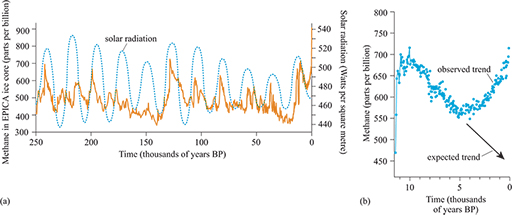4.3 Carbon dioxide (CO2), methane (CH4) and human activity
In recent decades, the understanding of the reality of climate change has moved from one of slow and gradual change over deep time to clear evidence that there have been naturally-occurring climate changes of several degrees Celsius and sea-level rises of half a metre within timescales of a decade or so (IPCC, 2013). In fact, research by Steffensen et al. (2008) on the Younger Dryas using ice core data revealed that central Greenland cooled by a staggering 2–4 °C in just 1–3 years, around ten times faster than the highest reconstructed rates of warming over the past two centuries (Box et al., 2009).
While the Younger Dryas and the 8.2 ka event were entirely natural, there is an additional human contribution to consider. But when exactly did the human contribution begin? Often the phrase ‘pre-industrial levels’ is used to mean ‘before significant anthropogenic changes started’, but it is not specific. Could humans have influenced the climate before the Industrial Revolution of the 18th century?
Another very significant greenhouse gas is methane (CH4), and 1 cubic metre of methane in the atmosphere can be over 25 times more effective at trapping heat than the same amount of CO2. Past atmospheric methane concentrations can also be directly measured from ice cores.
Over the last quarter of a million years, CH4 concentration and the variation of solar radiation reaching the Earth attributed to the Milankovitch cycle are positively correlated (Figure 24(a)). But this correlation dramatically breaks down in the most recent data of the Holocene.
The latest 5000 years of methane data show that the atmospheric concentration has risen dramatically out of synchrony with the solar radiation (Figure 24(b)). Three metres down in the EPICA ice core, dating to the 1820s, methane concentrations are as high as any period in the entire ice core record – approaching 800 ppb (parts per billion). Carbon dioxide has a similar break from the expected downward trend, although starting earlier, at about 8000 years ago.
If the ‘normal’ trend of methane and carbon dioxide was downwards, along with the Milankovitch cycle, then where have the extra gases come from?

Carbon dioxide and methane are by-products of civilisation. You often think of these by-products as beginning with the Industrial Revolution, but their story begins far earlier. In 2003, climate scientist William Ruddiman proposed that society had been altering the levels of these gases – and therefore influencing global climate – for many thousands of years. In his own words:
Human activities tied to farming – primarily agricultural deforestation and crop irrigation – must have added the extra CO2 and methane to the atmosphere.
Ruddiman suggests that these activities could have increased atmospheric concentrations by up to around 40 ppm for CO2 and 300 ppb for methane, increasing the expected natural levels by around 15% and 70% respectively (Ruddiman et al., 2016).
The amounts of CO2 and methane added to the atmosphere – and therefore the degree to which human activities changed the climate – during the agricultural era are still being debated, but now, of course, the human effect on these gases is clear.
As with CO2, since the Industrial Revolution the atmospheric concentration of methane has rapidly increased and currently is over 1800 ppb. Virtually all of that rise has been from anthropogenic sources, including major food production activities such as growing rice and cattle. Not only were humans possibly affected by climate change during the Holocene, but the impact by humans on the planet had already been started thousands of years before the Egyptian Pyramids were built. How then are these changes being seen today?
Activity 10 Recent climates
How does the Earth’s climate over the last 10 000 years compare with that of previous times, and what does this mean for humans in the future?
Answer
Over the last 10 000 years, the Earth’s climate appears to have remained in a warm, stable state for longer than was normal in the preceding climate cycles. This has probably been important for humans in that they have been able to develop agriculture and other aspects of civilisation without the major disruption that would be caused by the major rapid cooling associated with ice ages. This means that when the Earth becomes warmer in future, humans may be less well adapted to the climate.
